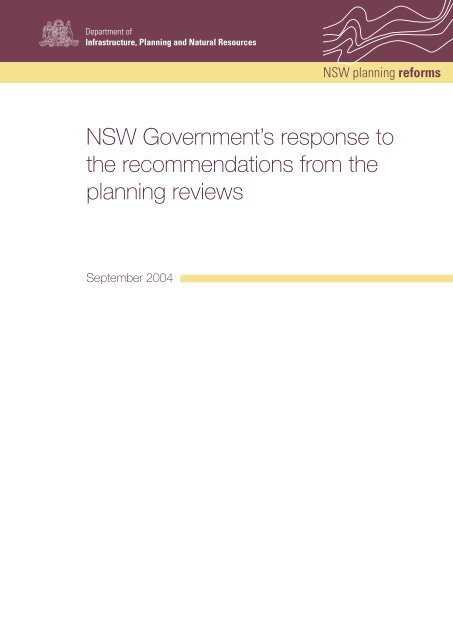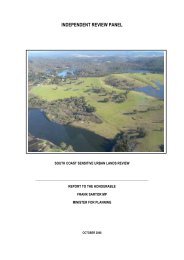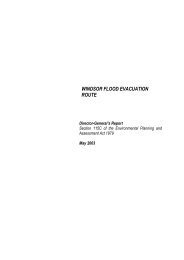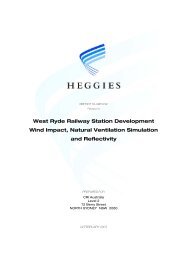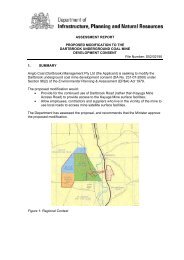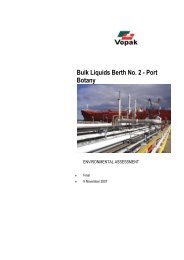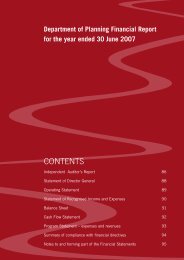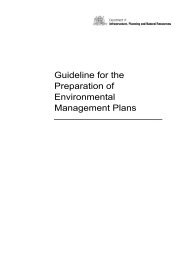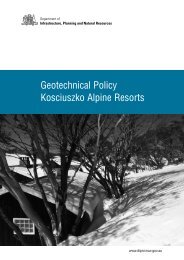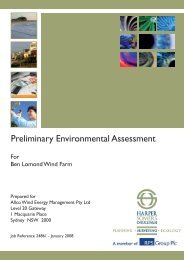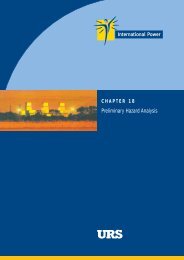NSW Government's response to the recommendations from the ...
NSW Government's response to the recommendations from the ...
NSW Government's response to the recommendations from the ...
You also want an ePaper? Increase the reach of your titles
YUMPU automatically turns print PDFs into web optimized ePapers that Google loves.
<strong>NSW</strong> planning reforms<br />
<strong>NSW</strong> Government’s <strong>response</strong> <strong>to</strong><br />
<strong>the</strong> <strong>recommendations</strong> <strong>from</strong> <strong>the</strong><br />
planning reviews<br />
September 2004
<strong>NSW</strong> Government’s <strong>response</strong> <strong>to</strong> <strong>the</strong> planning reviews I September 2004<br />
Preface<br />
In 2003, <strong>the</strong> Minister for Infrastructure and Planning and Minister for Natural Resources, and <strong>the</strong><br />
Minister for Infrastructure and Planning (Planning Administration) established a number of<br />
Taskforces <strong>to</strong> guide reform <strong>to</strong> specific aspects of <strong>the</strong> <strong>NSW</strong> planning system. The reviews<br />
examined:<br />
• statu<strong>to</strong>ry and strategic plan making<br />
• local development assessment<br />
• major development and infrastructure projects<br />
• Section 94 developer contributions<br />
• master planning<br />
• State environmental planning policies (including SEPP 5)<br />
• <strong>the</strong> Minister’s consent role.<br />
This information paper contains a summary of all <strong>the</strong> <strong>recommendations</strong> arising out of <strong>the</strong><br />
Taskforce reviews (except <strong>the</strong> major assessments and infrastructure review), and <strong>the</strong><br />
Government’s <strong>response</strong>. The final report of <strong>the</strong> Major Development and Infrastructure Projects<br />
Taskforce is still <strong>to</strong> be finalised.<br />
The planning reforms have been developed <strong>to</strong> bring <strong>to</strong>ge<strong>the</strong>r a comprehensive set of<br />
improvement measures <strong>to</strong> respond <strong>to</strong> <strong>the</strong> major issues identified in <strong>the</strong> various Taskforce<br />
reviews, and <strong>to</strong> target o<strong>the</strong>r issues within <strong>the</strong> planning system that have been identified outside of<br />
<strong>the</strong> Taskforce reviews.<br />
The terms of reference for each Taskforce are set out below:<br />
1. Plan Making Taskforce Review<br />
• Investigate and report on whe<strong>the</strong>r <strong>the</strong> Government should continue <strong>to</strong><br />
pursue <strong>the</strong> PlanFirst reforms, ei<strong>the</strong>r in <strong>to</strong>tal or in part.<br />
• Advise on any changes <strong>to</strong> <strong>the</strong> PlanFirst approach which may be<br />
necessary following <strong>the</strong> reorganisation of planning and natural resources<br />
management in <strong>the</strong> State.<br />
• Advise on how <strong>the</strong> strategic planning fee currently being collected on<br />
certain development applications should be used <strong>to</strong> progress reform of <strong>the</strong><br />
planning system.<br />
• Consult with stakeholders as necessary <strong>to</strong> ascertain views.<br />
2. Local Development Assessment Taskforce Review<br />
• Investigate and report on <strong>the</strong> development assessment and decision<br />
making process for local development under <strong>the</strong> Environmental<br />
Planning and Assessment Act and whe<strong>the</strong>r it is achieving an<br />
effective, quick, simple process that delivers quality outcomes.<br />
• Investigate <strong>the</strong> operation of <strong>the</strong> system of exempt and complying<br />
development and assess whe<strong>the</strong>r <strong>the</strong>re are common elements that<br />
provide opportunities for wider application.<br />
Department of Infrastructure, Planning and Natural Resources Page 1
<strong>NSW</strong> Government’s <strong>response</strong> <strong>to</strong> <strong>the</strong> planning reviews I September 2004<br />
• Examine how <strong>the</strong> Building Sustainability Index (BASIX) developed by<br />
<strong>the</strong> Department of Infrastructure, Planning and Natural Resources will<br />
interact with <strong>the</strong> approval system.<br />
• Provide advice on <strong>the</strong> impact of agencies concurrence and approval<br />
roles.<br />
• Consult with stakeholders as necessary <strong>to</strong> ascertain views.<br />
3. Section 94 Taskforce Review<br />
• Examine <strong>the</strong> previous report by <strong>the</strong> Department of Urban Affairs and Planning titled<br />
‘Review of <strong>the</strong> Developer Contributions System 2000’ and advise on those aspects of<br />
<strong>the</strong> report that merit fur<strong>the</strong>r investigation and whe<strong>the</strong>r some changes could be<br />
implemented immediately as part of an interim reform package.<br />
• Examine and report on <strong>the</strong> original policy basis and rationale for <strong>the</strong> introduction of<br />
Section 94 contributions and whe<strong>the</strong>r it remains a legitimate basis for levying<br />
development at a local level.<br />
! ga<strong>the</strong>r and analyse data on <strong>the</strong> existing Section 94 system including:<br />
! <strong>the</strong> <strong>to</strong>tal value of adopted contributions plans in <strong>NSW</strong><br />
! <strong>the</strong> <strong>to</strong>tal value of contributions collected and works-in-kind undertaken for local<br />
councils during <strong>the</strong> previous 5 years<br />
! <strong>the</strong> use of developer agreements in lieu of monetary contributions<br />
! <strong>the</strong> <strong>to</strong>tal estimated value of approved development in <strong>NSW</strong> during <strong>the</strong> previous<br />
5 years<br />
! <strong>the</strong> <strong>to</strong>tal shortfall between collected contributions and <strong>the</strong> cost of works<br />
undertaken.<br />
• Review <strong>the</strong> range of levies, taxes and charges (including <strong>the</strong> PlanFirst fee) currently<br />
paid at land development stage and assess <strong>the</strong>ir impact on <strong>the</strong> affordability of<br />
housing and <strong>the</strong>ir success (or o<strong>the</strong>rwise) in funding <strong>the</strong> provision of local<br />
infrastructure.<br />
• Examine alternatives <strong>to</strong> levying under Section 94 of <strong>the</strong> Environmental Planning and<br />
Assessment Act 1979 (such as flat rate levies and developer agreements), identify<br />
<strong>the</strong>ir strengths and weaknesses, report on <strong>the</strong> feasibility of using different systems for<br />
Metropolitan Development Program and o<strong>the</strong>r areas and examine <strong>the</strong><br />
appropriateness of <strong>the</strong> nexus and whe<strong>the</strong>r o<strong>the</strong>r arrangements are more appropriate.<br />
• Advise on implementation mechanisms for any alternative models (and whe<strong>the</strong>r a<br />
range of models are appropriate) including transitional arrangements and <strong>the</strong><br />
management of associated risks.<br />
• Examine existing accountability arrangements and identify ways in which <strong>the</strong> system<br />
could become more transparent and <strong>the</strong> community more confident about Section 94<br />
expenditure.<br />
• Advise on <strong>the</strong> role of Section 94 in funding local infrastructure, having particular<br />
regard <strong>to</strong> <strong>the</strong> impacts of local government rate pegging and debt servicing.<br />
• Consult with stakeholders as necessary <strong>to</strong> ascertain views.<br />
Department of Infrastructure, Planning and Natural Resources Page 2
<strong>NSW</strong> Government’s <strong>response</strong> <strong>to</strong> <strong>the</strong> planning reviews I September 2004<br />
4. Ministerial Consent Role Taskforce Review<br />
• Review <strong>the</strong> Minister’s consent role under major metropolitan and non-metro planning<br />
instruments, including SEPP 47 – Fox Studios, SEPP 56 – Sydney Harbour<br />
Foreshore & Tributaries, SREP 16 – Walsh Bay, SREP 24 – Homebush Bay, SREP<br />
26 – City West and SEPP 73 – Kosciuszko Ski Resorts.<br />
• Recommend amendments and timeframe needed <strong>to</strong> ensure <strong>the</strong> consent role is only<br />
focussed on matters of State significance.<br />
• Review what constitutes State Significant Development across <strong>the</strong> Department and<br />
advise on any changes necessary <strong>to</strong> ensure <strong>the</strong> role is properly and strategically<br />
targeted.<br />
5. Masterplan Taskforce Review<br />
• Review <strong>the</strong> growing reliance on masterplans by consent authorities and advise<br />
circumstances when such plans are appropriate.<br />
• Advise on any procedural or legislative changes needed <strong>to</strong> guide <strong>the</strong>ir use, including<br />
examining <strong>the</strong> relationship between masterplans and development control plans.<br />
6. State Environmental Planning Policies (SEPP) Taskforce Review<br />
• Review and rationalise existing State policies in<strong>to</strong> a clear, strategic framework which<br />
will guide regional and local planning.<br />
• Develop indica<strong>to</strong>rs against which <strong>to</strong> measure <strong>the</strong> success of policies.<br />
• Consult with o<strong>the</strong>r State agencies as relevant.<br />
7. SEPP 5 Taskforce Review<br />
• Review <strong>the</strong> housing strategy <strong>to</strong> be pursued for Older People and People with a<br />
Disability including any changes <strong>to</strong> be made <strong>to</strong> SEPP 5 based on:<br />
! <strong>the</strong> market demand projections for housing for older people<br />
! <strong>the</strong> opportunities for large-scale retirement villages<br />
! how we can best provide for independent living and supported accommodation<br />
(<strong>from</strong> villa <strong>to</strong> nursing home)<br />
! <strong>the</strong> capacity <strong>to</strong> expand <strong>the</strong> product and service range of housing for older<br />
people and people with a disability and specialised housing<br />
! <strong>the</strong> need for affordable housing.<br />
• Advise on whe<strong>the</strong>r <strong>the</strong> apparent inconsistency in bush-fire prone areas between <strong>the</strong><br />
opportunities for conventional housing (eg subdivision and dual occupancy) and<br />
housing for older people in unreasonable<br />
8. Major Development and Infrastructure Taskforce Review<br />
• Identify current issues and emerging trends in <strong>the</strong> assessment and approval of major<br />
developments and infrastructure projects (by both <strong>the</strong> private and public sec<strong>to</strong>r).<br />
• Develop options for an integrated, single and strategic system which addresses<br />
infrastructure, environmental planning and natural resources. The system should<br />
address administrative and/or regula<strong>to</strong>ry reforms; and strategic considerations.<br />
• Recommend <strong>the</strong> elements of an integrated regime including administrative<br />
arrangements, policy and practices, <strong>to</strong> deliver sustainable outcomes and streng<strong>the</strong>n<br />
stakeholder participation.<br />
Department of Infrastructure, Planning and Natural Resources Page 3
<strong>NSW</strong> Government’s <strong>response</strong> <strong>to</strong> <strong>the</strong> planning reviews I September 2004<br />
Contents<br />
1 Plan Making Taskforce Review 5<br />
2 Local Development Assessment Taskforce Review 8<br />
3 Section 94 Contributions Taskforce Review 14<br />
4 Ministerial Consent Role Taskforce Review 19<br />
5 Masterplan Taskforce Review 21<br />
6 SEPP Taskforce Review 24<br />
7 SEPP 5 Taskforce Review 25<br />
Department of Infrastructure, Planning and Natural Resources Page 4
<strong>NSW</strong> Government’s <strong>response</strong> <strong>to</strong> <strong>the</strong> planning reviews I September 2004<br />
1 Plan Making Taskforce Review<br />
Recommendations - Summary<br />
The most significant issue for Sydney at this time<br />
is <strong>the</strong> need <strong>to</strong> develop a new metropolitan<br />
strategy.<br />
Government Response<br />
Supported.<br />
Metropolitan Strategy underway.<br />
The Department of Infrastructure, Planning and<br />
Natural Resources (DIPNR) should prepare nonstatu<strong>to</strong>ry<br />
regional strategies <strong>to</strong> guide and direct<br />
<strong>the</strong> sustainable development, growth and change<br />
of regions and <strong>the</strong>se strategies should address<br />
environmental, social and economic outcomes<br />
along with infrastructure and programs required <strong>to</strong><br />
support those outcomes.<br />
Supported.<br />
Regional strategies will be developed in priority growth<br />
regions:<br />
• <strong>NSW</strong> Coast including Far North Coast, Lower<br />
Hunter and South Coast<br />
• Sydney – Canberra corridor<br />
• key centres in Western <strong>NSW</strong>.<br />
Regional planning must be developed <strong>to</strong> meet <strong>the</strong><br />
needs of metropolitan, coastal and inland <strong>NSW</strong>.<br />
DIPNR must immediately target high priority areas<br />
for <strong>the</strong> commencement of regional planning<br />
initiatives.<br />
In lieu of regional forums, DIPNR should employ<br />
appropriate methods of consultation and<br />
involvement (including where necessary Section<br />
22 committees) based on <strong>the</strong> particular regional<br />
planning activities that is being undertaken and<br />
<strong>the</strong> priority for completion of that activity.<br />
Supported.<br />
Regional strategies should be moni<strong>to</strong>red by<br />
DIPNR and <strong>the</strong>ir performance reviewed regularly.<br />
Supported.<br />
Regional strategies should be delivered in an<br />
electronic format.<br />
Supported.<br />
The format of a local plan be regulated by <strong>the</strong><br />
State government and be specified <strong>to</strong> contain<br />
content that is fixed by <strong>the</strong> State and manda<strong>to</strong>ry<br />
for every integrated local plan.<br />
Supported.<br />
Working draft Standard Provisions for LEPs in <strong>NSW</strong><br />
released for comment.<br />
DIPNR be required <strong>to</strong> fur<strong>the</strong>r develop <strong>the</strong><br />
Taskforce’s proposed integrated plan template for<br />
inclusion in <strong>the</strong> EP&A Regulation as a standard<br />
template before 31 December 2003.<br />
Supported. A proposed template for LEPs is included<br />
in <strong>the</strong> working draft Standard Provisions for LEPs in<br />
<strong>NSW</strong> released for public comment.<br />
Department of Infrastructure, Planning and Natural Resources Page 5
<strong>NSW</strong> Government’s <strong>response</strong> <strong>to</strong> <strong>the</strong> planning reviews I September 2004<br />
Recommendations - Summary<br />
DIPNR develop a set of best practice guidelines<br />
for integrated plan preparation for local councils,<br />
before 31 December 2003 <strong>to</strong> provide clarity and<br />
detail on <strong>the</strong> new template and ensure <strong>the</strong><br />
efficient preparation of new integrated plans.<br />
The Parliamentary Counsel's Office be requested<br />
<strong>to</strong> approve <strong>the</strong> final integrated plan template,<br />
including <strong>the</strong> standard set of zones, definitions<br />
and model provisions, upon completion of same<br />
by DIPNR.<br />
Government Response<br />
Supported. Guidelines will be prepared <strong>to</strong> support <strong>the</strong><br />
new template and standard provisions for local<br />
environmental plans.<br />
Supported.<br />
Establish a dedicated team of staff (who will liaise<br />
with local government officers) <strong>to</strong> ensure that<br />
above <strong>recommendations</strong> are implemented before<br />
31 December 2003.<br />
Supported.<br />
A later timeframe is appropriate in order <strong>to</strong> consider<br />
<strong>recommendations</strong> arising <strong>from</strong> all Taskforce reviews.<br />
The Minister for Local Government be requested<br />
<strong>to</strong> encourage councils <strong>to</strong> prepare a long term<br />
strategic plan for every local government area<br />
(LGA) in <strong>NSW</strong>.<br />
Supported.<br />
The Minister for Infrastructure and Planning will<br />
request <strong>the</strong> Minister for Local Government <strong>to</strong> update<br />
<strong>the</strong> Management Planning Guidelines 2000 <strong>to</strong><br />
encourage councils <strong>to</strong> undertake local strategic<br />
planning.<br />
The Minister for Local Government develop a set<br />
of best practice guidelines before 31 March 2004<br />
(following consultation with local government) for<br />
<strong>the</strong> preparation of local government management<br />
plans and strategic plans.<br />
Supported in principle.<br />
It is proposed that <strong>the</strong> existing Management Planning<br />
Guidelines be revised.<br />
It be manda<strong>to</strong>ry for councils <strong>to</strong> consolidate <strong>the</strong>ir<br />
planning instruments in<strong>to</strong> a maximum of one<br />
integrated plan for every LGA and that DIPNR<br />
tailor a suitably staged timetable for this <strong>to</strong> occur,<br />
with metropolitan, coastal and amalgamated<br />
councils <strong>to</strong> be targeted as a priority.<br />
Supported.<br />
Local councils in priority areas will be required <strong>to</strong><br />
develop a new local environmental plan within three<br />
years.<br />
Consultation <strong>to</strong> occur with local government <strong>to</strong><br />
assist <strong>the</strong> Department of Local Government and<br />
DIPNR in <strong>the</strong> efficient development of best<br />
practice guidelines and <strong>to</strong> ensure <strong>the</strong><br />
implementation of <strong>the</strong>se <strong>recommendations</strong> by<br />
local government within an agreed timeframe.<br />
Supported.<br />
Department of Infrastructure, Planning and Natural Resources Page 6
<strong>NSW</strong> Government’s <strong>response</strong> <strong>to</strong> <strong>the</strong> planning reviews I September 2004<br />
Recommendations - Summary<br />
DIPNR investigate opportunities <strong>to</strong> delegate<br />
aspects of <strong>the</strong> Minister’s local environmental plan<br />
(LEP) approval role <strong>to</strong> local councils where<br />
integrated plan provisions are consistent with<br />
State and regional objectives.<br />
Government Response<br />
Supported in principle.<br />
The Section 94 Review Taskforce be requested <strong>to</strong><br />
examine <strong>the</strong> retention (or o<strong>the</strong>rwise) of <strong>the</strong><br />
strategic planning fee as part of <strong>the</strong> terms of<br />
reference of that Taskforce.<br />
Included as part of terms of reference.<br />
DIPNR review <strong>the</strong> retention (or o<strong>the</strong>rwise) of <strong>the</strong><br />
strategic planning fee after all <strong>the</strong> current planning<br />
system reviews are completed.<br />
Supported in principle.<br />
It is expected that collection of <strong>the</strong> fee will cease when<br />
<strong>the</strong> planning reforms have been implemented.<br />
DIPNR provide clarity in regard <strong>to</strong> <strong>the</strong> imposition<br />
of <strong>the</strong> strategic planning fee.<br />
Supported.<br />
Revenue collected <strong>to</strong> date should be shared<br />
equally between State and local government.<br />
Sharing of revenue with local government is supported.<br />
$8.3 million has already been allocated <strong>to</strong> local<br />
councils <strong>from</strong> <strong>the</strong> Planning Reform fund. The 2004–05<br />
round will be targeted <strong>to</strong> local councils for<br />
implementing priority planning reforms.<br />
DIPNR urgently develop a comprehensive<br />
strategy for spending <strong>the</strong> fee revenue that targets<br />
local government.<br />
Supported.<br />
Consider developing integrated land use and<br />
natural resources legislation.<br />
Supported as a long-term reform objective.<br />
DIPNR develop a suitable communications<br />
strategy, with particular focus on managing <strong>the</strong><br />
expectation of key regional stakeholders.<br />
Supported.<br />
Department of Infrastructure, Planning and Natural Resources Page 7
<strong>NSW</strong> Government’s <strong>response</strong> <strong>to</strong> <strong>the</strong> planning reviews I September 2004<br />
2 Local Development Assessment Taskforce Review<br />
Recommendations - Summary<br />
Common Housing Standards<br />
Prepare a common set of housing standards;<br />
testing and consultation with local government<br />
and industry; incorporation in<strong>to</strong> integrated plan<br />
template.<br />
Investigate preparation of exempt and complying<br />
development controls for commercial and<br />
industrial development for inclusion in integrated<br />
plan template.<br />
Review exempt provisions of State environmental<br />
planning policy (SEPP) 60 for inclusion in<br />
integrated plan template.<br />
(Recommendations 1 - 5)<br />
Complying Development<br />
Allow for conditions <strong>to</strong> be imposed on complying<br />
development certificates where a breach of a<br />
single standard occurs.<br />
Investigate opportunities <strong>to</strong> increase <strong>the</strong> use of<br />
complying development in environmentally<br />
sensitive areas.<br />
Request <strong>the</strong> Department of Local Government<br />
(DLG) <strong>to</strong> moni<strong>to</strong>r <strong>the</strong> granting of complying<br />
development certificates on an annual basis.<br />
(Recommendations 6, 7, 10)<br />
Government Response<br />
Supported partially.<br />
Exempt and complying development provisions for<br />
internal renovations of houses, and small-scale<br />
commercial/industrial development <strong>to</strong> be prepared.<br />
Not supported.<br />
Moni<strong>to</strong>ring and Review<br />
Investigate opportunities for a combined<br />
approvals system for single dwelling houses (in<br />
situations where a separate development<br />
application (DA) and construction certificate is still<br />
required).<br />
Not supported.<br />
Implement a moni<strong>to</strong>ring program <strong>to</strong> ensure a<br />
review of <strong>the</strong> housing standards and model<br />
notification policy after 2 years of operation.<br />
(Recommendations 8, 9, 23)<br />
Clearer Standards<br />
Prepare best practice guidelines for writing clear<br />
standards and developing policy in consultation<br />
with local government and State agencies.<br />
Prepare communications and education strategy<br />
on <strong>the</strong> writing of clear standards and policy.<br />
(Recommendations 11 - 13)<br />
Supported.<br />
Guidance material for local councils will be prepared <strong>to</strong><br />
support <strong>the</strong> LEP template and <strong>the</strong> preparation of new<br />
local environmental plans.<br />
Department of Infrastructure, Planning and Natural Resources Page 8
<strong>NSW</strong> Government’s <strong>response</strong> <strong>to</strong> <strong>the</strong> planning reviews I September 2004<br />
Recommendations - Summary<br />
Format and Content of Local Plans<br />
Regulate <strong>the</strong> format of local plans (integrated plan<br />
template) and incorporate standard definitions<br />
and model provisions.<br />
(Recommendations 14 - 17)<br />
Notification<br />
Limit notification of DAs and complying<br />
development certificates that comply with <strong>the</strong><br />
common housing standards, <strong>to</strong> notification that an<br />
approval has been granted.<br />
Notification of single dwelling houses <strong>to</strong> occur<br />
only when <strong>the</strong>re is a variation <strong>to</strong> <strong>the</strong> common<br />
housing standards.<br />
Preparation of a model notification policy for local<br />
development in consultation with <strong>the</strong> Independent<br />
Commission Against Corruption (ICAC) and local<br />
government.<br />
Review EP&A Act advertising and notification<br />
provisions <strong>to</strong> ensure <strong>the</strong>y remain contemporary<br />
and provide flexibility.<br />
(Recommendations 18 - 21)<br />
Request <strong>the</strong> Ministerial Consents Role Taskforce<br />
<strong>to</strong> provide that <strong>the</strong> model notification policy be<br />
implemented when assessing DAs where <strong>the</strong><br />
Minister is <strong>the</strong> consent authority.<br />
Government Response<br />
Supported.<br />
Not supported.<br />
Model notification policy being developed.<br />
Ministerial Consents Role Taskforce had already<br />
completed its report.<br />
(Recommendation 22)<br />
BASIX<br />
BASIX must dovetail with <strong>the</strong> provisions of<br />
existing sustainability guidelines <strong>to</strong> ensure<br />
consistency and avoid duplication.<br />
Prepare communications and education strategy.<br />
Develop a SEPP or regulation amendment <strong>to</strong><br />
introduce manda<strong>to</strong>ry water and energy use<br />
provisions of BASIX.<br />
Supported. BASIX is progressively being<br />
implemented.<br />
(Recommendations 24, 26, 28)<br />
Department of Infrastructure, Planning and Natural Resources Page 9
<strong>NSW</strong> Government’s <strong>response</strong> <strong>to</strong> <strong>the</strong> planning reviews I September 2004<br />
Recommendations - Summary<br />
Develop BASIX <strong>to</strong> ensure that it becomes a<br />
relevant <strong>to</strong>ol for non-residential development and<br />
o<strong>the</strong>r activities (eg: land subdivision, demolition).<br />
Government Response<br />
Support in principle.<br />
Accreditation schemes be provided <strong>to</strong> enable<br />
building industry practitioners <strong>to</strong> be accredited <strong>to</strong><br />
certify compliance with BASIX.<br />
Incorporate manda<strong>to</strong>ry water and energy indices<br />
in<strong>to</strong> <strong>the</strong> integrated plan template.<br />
(Recommendations 25, 27, 29)<br />
Consultation and Concurrence<br />
Current review of SEPPs and preparation of<br />
regional strategies by DIPNR <strong>to</strong> remove as far as<br />
possible, existing consultation and concurrence<br />
provisions.<br />
(Recommendation 30)<br />
Supported.<br />
State Agency Roles<br />
Review integrated development approvals<br />
process.<br />
Supported.<br />
(Recommendation 31)<br />
Certification<br />
Confirm <strong>the</strong> appropriate authority responsible for<br />
<strong>the</strong> auditing of accredited certifiers, managing <strong>the</strong><br />
complaints handling process and undertaking<br />
enforcement actions.<br />
Facilitate <strong>the</strong> transfer of responsibility for <strong>the</strong><br />
establishment of <strong>the</strong> Building Professionals Board<br />
and <strong>the</strong> auditing of certifiers <strong>from</strong> DIPNR <strong>to</strong> <strong>the</strong><br />
Department of Commerce.<br />
The <strong>Government's</strong> <strong>response</strong> <strong>to</strong> <strong>the</strong> Campbell<br />
Inquiry reforms <strong>to</strong> <strong>the</strong> certification process be<br />
introduced as soon as possible.<br />
(Recommendations 32, 33, 35)<br />
Supported.<br />
Relevant accreditation bodies are responsible for <strong>the</strong><br />
auditing complaints and accreditation. Councils can<br />
take action against non-compliance with consent and<br />
construction certificate.<br />
Following actions underway:<br />
• Stage 1 of Building Professionals Board (BPB)<br />
now established within DIPNR.<br />
• Building Legislation Act and EP&A Amendment<br />
(Quality of Construction) Act 2003 all now<br />
commenced.<br />
• Manda<strong>to</strong>ry inspections and on-site signage for low<br />
rise buildings commenced on 1 July 2004.<br />
Department of Infrastructure, Planning and Natural Resources Page 10
<strong>NSW</strong> Government’s <strong>response</strong> <strong>to</strong> <strong>the</strong> planning reviews I September 2004<br />
Recommendations - Summary<br />
Annual reporting of accreditation, investigation,<br />
auditing and education processes by Home<br />
Building Service.<br />
Amend <strong>the</strong> Guiding Development: Better<br />
Outcomes publication <strong>to</strong> introduce advice relating<br />
<strong>to</strong> certification practices.<br />
Government Response<br />
Supported.<br />
Quality of Construction Act package has a practice<br />
note and fact sheets about key roles and<br />
responsibilities.<br />
Prepare a 'ready reckoner' which summaries <strong>the</strong><br />
responsibilities of certifiers.<br />
Clarify <strong>the</strong> meaning of 'not inconsistent' in <strong>the</strong><br />
assessment of an application for a construction<br />
certificate (for <strong>the</strong> purposes of Section 96 EP&A<br />
Act modifications)<br />
(Recommendations 34, 36, 37, 56)<br />
Role of Councillors<br />
Provide greater clarity regarding <strong>the</strong> role of<br />
councillors in <strong>the</strong> environmental planning process.<br />
Require all newly elected councillors and reelected<br />
councillors <strong>to</strong> attend manda<strong>to</strong>ry training<br />
courses.<br />
(Recommendations 38 - 41)<br />
Voluntary training is supported in principle.<br />
DIPNR <strong>to</strong> encourage training courses <strong>to</strong> be developed<br />
by universities, Local Government & Shires<br />
Associations (LGSA) and o<strong>the</strong>r professional<br />
associations.<br />
Independent Assessment Panels<br />
Provide for <strong>the</strong> establishment of independent<br />
development assessment and hearing panels.<br />
Establish regional panels where requested.<br />
Amend SEPP 65 in relation <strong>to</strong> design review<br />
panels.<br />
The ongoing establishment of independent<br />
assessment panels by local councils, on a voluntary<br />
basis, is supported.<br />
(Recommendations 42 - 45)<br />
Council Performance<br />
Require all councils <strong>to</strong> report within 12 months of<br />
commencement of legislation and annually<br />
<strong>the</strong>reafter, on how <strong>the</strong>y have achieved specific<br />
performance benchmarks, <strong>to</strong> ascertain <strong>the</strong>ir<br />
effectiveness (or o<strong>the</strong>rwise) in reducing<br />
determination times and achieving quality<br />
outcomes.<br />
Supported.<br />
Moni<strong>to</strong>ring package <strong>to</strong> be put in place <strong>to</strong> ensure all<br />
councils report after 18 months <strong>from</strong> commencement<br />
of legislative changes and annually <strong>the</strong>reafter, on how<br />
<strong>the</strong>y have achieved specific performance benchmarks<br />
in approving DA processing times.<br />
(Recommendation 46)<br />
Department of Infrastructure, Planning and Natural Resources Page 11
<strong>NSW</strong> Government’s <strong>response</strong> <strong>to</strong> <strong>the</strong> planning reviews I September 2004<br />
Recommendations - Summary<br />
Government Response<br />
Planning Education<br />
The Planning Institute of Australia (PIA) develop a<br />
professional planning practice course (as part of<br />
its National Inquiry in<strong>to</strong> Planning Education and<br />
Employment.<br />
Supported. DIPNR will request PIA <strong>to</strong> action<br />
recommendation.<br />
PIA be encouraged <strong>to</strong> develop a men<strong>to</strong>ring<br />
program for junior assessment staff.<br />
(Recommendations 47, 48)<br />
Preparation of communications strategies by<br />
councils <strong>to</strong> help clarify development assessment<br />
processes for community and development<br />
groups.<br />
Develop an ongoing education action plan <strong>to</strong><br />
provide for a comprehensive system of planning<br />
education in <strong>NSW</strong>.<br />
Not supported.<br />
Planning education is best delivered by professional<br />
associations, LGSA and universities. DIPNR will<br />
continue <strong>to</strong> encourage <strong>the</strong>se bodies <strong>to</strong> enhance<br />
training programs.<br />
Establish a planning education council <strong>to</strong> assist in<br />
<strong>the</strong> development and implementation of <strong>the</strong><br />
education action plan.<br />
(Recommendations 49 - 51)<br />
Allocate resources <strong>to</strong>wards planning education<br />
and practice <strong>to</strong> ensure improvement of<br />
development assessment practices.<br />
Not supported.<br />
(Recommendation 52)<br />
Process Management<br />
Review <strong>the</strong> appropriateness of applying Sections<br />
102-104 EP&A Act (process challenges) <strong>to</strong> local<br />
development approvals issued by councils.<br />
Supported in principle.<br />
(Recommendation 53)<br />
Practice Manuals<br />
Update Guiding Development: Better Outcomes<br />
<strong>to</strong> include advice on managing <strong>the</strong> development<br />
assessment process by State agencies and<br />
councils.<br />
Introduce a service providing on-call planning<br />
guidance and assistance <strong>to</strong> councils.<br />
Supported in principle. Necessary explana<strong>to</strong>ry material<br />
and practice notes will be developed <strong>to</strong> support <strong>the</strong><br />
reforms.<br />
On-call planning guidance not supported.<br />
(Recommendations 54, 55)<br />
Department of Infrastructure, Planning and Natural Resources Page 12
<strong>NSW</strong> Government’s <strong>response</strong> <strong>to</strong> <strong>the</strong> planning reviews I September 2004<br />
Recommendations - Summary<br />
DA Fees<br />
Develop an action plan <strong>to</strong> progress <strong>the</strong><br />
implementation of <strong>the</strong> Independent Pricing and<br />
Regula<strong>to</strong>ry Tribunal (IPART) <strong>recommendations</strong><br />
relating <strong>to</strong> development assessment fees.<br />
Government Response<br />
Supported.<br />
(Recommendation 57)<br />
Fast Track DA Fees<br />
Review <strong>the</strong> use of 'fast track' DA fees <strong>to</strong> allow<br />
councils <strong>to</strong> apply <strong>to</strong> DIPNR for approval <strong>to</strong> charge<br />
fast track fees.<br />
Supported.<br />
(Recommendation 58)<br />
Performance Moni<strong>to</strong>ring<br />
Commence <strong>the</strong> collection of annual statistics in<br />
relation <strong>to</strong> complying development certificates<br />
and construction certificates on an annual basis.<br />
(Recommendation 59)<br />
Supported in principle. Moni<strong>to</strong>ring package <strong>to</strong> be put in<br />
place <strong>to</strong> ensure all councils report after 18 months <strong>from</strong><br />
commencement of legislative changes and annually<br />
<strong>the</strong>reafter, on how <strong>the</strong>y have achieved specific<br />
performance benchmarks in approving DA processing<br />
times.<br />
Benchmarking<br />
Develop appropriate benchmarks and moni<strong>to</strong>ring<br />
of <strong>the</strong> development assessment process.<br />
Supported.<br />
(Recommendation 60)<br />
Delegations<br />
Amend Guiding Development: Better Outcomes<br />
<strong>to</strong> include a model delegation policy for local<br />
government.<br />
(Recommendation 61)<br />
Not supported.<br />
Delegations <strong>to</strong> planning staff are a matter for individual<br />
local councils.<br />
Department of Infrastructure, Planning and Natural Resources Page 13
<strong>NSW</strong> Government’s <strong>response</strong> <strong>to</strong> <strong>the</strong> planning reviews I September 2004<br />
3 Section 94 Contributions Taskforce Review<br />
Recommendations - Summary<br />
The original policy basis for Section 94 generally<br />
remains a sound and legitimate basis for levying<br />
development at <strong>the</strong> local level, on <strong>the</strong> basis that<br />
<strong>the</strong> o<strong>the</strong>r Taskforce <strong>recommendations</strong> are<br />
implemented.<br />
Government Response<br />
Supported.<br />
The Taskforce supports those <strong>recommendations</strong><br />
<strong>from</strong> <strong>the</strong> previous report Review of <strong>the</strong> Developer<br />
Contributions System 2000 as set out in Table 1<br />
(on page 20 of <strong>the</strong> report).<br />
Supported.<br />
The Department of Local Government be<br />
requested <strong>to</strong> collect and publish <strong>from</strong> each<br />
council in <strong>NSW</strong> on an annual basis, Section 94<br />
data relating <strong>to</strong> <strong>the</strong>:<br />
• value of adopted contributions plans.<br />
• value of contributions collected.<br />
• value of infrastructure constructed.<br />
• value of works-in-kind agreements entered<br />
in<strong>to</strong>.<br />
• value of developer agreements entered in<strong>to</strong>.<br />
• projected value of contributions <strong>to</strong> be<br />
collected over <strong>the</strong> next 5 years.<br />
• projected infrastructure expenditure over <strong>the</strong><br />
next 5 years.<br />
Supported.<br />
All contributions plans include an estimate of <strong>the</strong><br />
likely revenue <strong>from</strong> Section 94 along with a<br />
schedule for infrastructure delivery on a time<br />
series basis. This time series should be for at<br />
least a 5 year interval.<br />
Supported.<br />
Collection of <strong>the</strong> ‘PlanFirst’ fee should cease at<br />
<strong>the</strong> end of <strong>the</strong> 2003/04 financial year and any<br />
remaining monies should be disbursed according<br />
<strong>to</strong> <strong>the</strong> criteria and principles set out in <strong>the</strong><br />
PlanFirst Review Taskforce Report.<br />
Not supported.<br />
The planning reform fee will be retained until planing<br />
reforms have been implemented.<br />
Section 94 contributions plans are an appropriate<br />
model for funding local infrastructure in greenfield<br />
growth or urban redevelopment areas with<br />
multiple owners.<br />
Supported.<br />
Department of Infrastructure, Planning and Natural Resources Page 14
<strong>NSW</strong> Government’s <strong>response</strong> <strong>to</strong> <strong>the</strong> planning reviews I September 2004<br />
Recommendations - Summary<br />
Developer agreements and works-in-kind<br />
agreements are an appropriate model for funding<br />
local infrastructure where <strong>the</strong> negotiation effort is<br />
efficient and effective, typically in high growth<br />
areas with one or few owners.<br />
Government Response<br />
Supported.<br />
Flat rate percentage levies are an appropriate<br />
alternative model for funding local infrastructure in<br />
all o<strong>the</strong>r areas. The application of a flat<br />
percentage levy should be optional and be<br />
applied as an alternative <strong>to</strong> a Section 94<br />
contributions plan (ie: only one mechanism can<br />
be in operation for a particular area). A framework<br />
for limiting <strong>the</strong> quantum of flat percentage levies<br />
needs <strong>to</strong> be established <strong>to</strong> ensure that it is an<br />
appropriate level for <strong>the</strong> appropriate<br />
circumstance.<br />
Supported.<br />
DIPNR be requested <strong>to</strong> develop clear principles<br />
applying <strong>to</strong> <strong>the</strong> developer agreements and flat<br />
percentage levy models that are reflected in a<br />
revised Section 94 Contributions Plans Manual.<br />
Supported.<br />
DIPNR prepare guidelines (as part of a revised<br />
Section 94 Contributions Plans Manual) <strong>to</strong> assist<br />
best practice land development, including <strong>the</strong><br />
most efficient use of land assets with regard <strong>to</strong><br />
<strong>the</strong> orderly and economic release of land on<br />
development fronts within <strong>the</strong> Metropolitan<br />
Development Program.<br />
Supported.<br />
In this regard, <strong>the</strong> Taskforce recommends that<br />
councils be required <strong>to</strong> undertake detailed<br />
precinct planning as part of any rezoning exercise<br />
in Metropolitan Development Program areas.<br />
This precinct planning should occur at a level<br />
such that Section 94 contributions plans and/or<br />
developer agreements accurately relate <strong>to</strong> <strong>the</strong><br />
nature of infrastructure <strong>to</strong> be provided and <strong>the</strong><br />
staging of development fronts. This planning<br />
should occur prior <strong>to</strong> <strong>the</strong> gazettal of any rezonings<br />
in Metropolitan Development Program areas.<br />
DIPNR formulate measures <strong>to</strong> encourage<br />
development collaboration for land dedication<br />
costs <strong>to</strong> be internalised by <strong>the</strong> developer.<br />
Supported.<br />
Department of Infrastructure, Planning and Natural Resources Page 15
<strong>NSW</strong> Government’s <strong>response</strong> <strong>to</strong> <strong>the</strong> planning reviews I September 2004<br />
Recommendations - Summary<br />
DIPNR revise <strong>the</strong> Section 94 Contributions Plans<br />
Manual <strong>to</strong> incorporate a consistent format for<br />
contributions plans.<br />
Government Response<br />
Supported.<br />
In this regard, <strong>the</strong> Taskforce recommends that in<br />
addition <strong>to</strong> <strong>the</strong> items already listed in <strong>the</strong> sample<br />
contributions plan in <strong>the</strong> current Section 94<br />
Manual, contributions plans should also contain:<br />
• a table showing how indexation of<br />
contributions is calculated and where <strong>to</strong><br />
obtain indexation details.<br />
• <strong>the</strong> works schedule containing cost estimates<br />
and proposed timing of infrastructure<br />
provision (ei<strong>the</strong>r date or threshold based). It<br />
should also indicate which of <strong>the</strong> items have<br />
been provided.<br />
• easy <strong>to</strong> read maps showing location of<br />
Section 94 items.<br />
• a schedule showing <strong>the</strong> extent of<br />
development that has occurred (eg: number<br />
of lots developed, percentage of contributions<br />
paid).<br />
The EP&A Regulation be amended <strong>to</strong> require that<br />
all contributions plans include a summary<br />
schedule of rates.<br />
The review period of contributions plan should not<br />
exceed 5 years, plans not reviewed within 5 years<br />
should cease <strong>to</strong> operate. Regular review<br />
(preferably annually - with land values reviewed<br />
quarterly) of a contributions plan needs <strong>to</strong> include<br />
an examination of <strong>the</strong> variables affecting <strong>the</strong><br />
contribution rate.<br />
Supported in principle.<br />
A standard checklist of variables be included in a<br />
revised Section 94 Contributions Plans Manual.<br />
The Section 94 Contributions Plans Manual be<br />
revised <strong>to</strong>:<br />
• include a standard report template (for<br />
reporting Section 94 contributions plans and<br />
<strong>the</strong>ir reviews <strong>to</strong> council).<br />
• encourage <strong>the</strong> establishment of a stakeholder<br />
register <strong>to</strong> improve <strong>the</strong> notification process of<br />
draft contributions plans.<br />
• include an example of <strong>the</strong> type and format of<br />
information <strong>to</strong> be exhibited when reviewing a<br />
contributions plan.<br />
Supported.<br />
A template for cash flow analysis be prepared<br />
and incorporated in<strong>to</strong> <strong>the</strong> Section 94<br />
Contributions Plans Manual.<br />
Supported.<br />
Department of Infrastructure, Planning and Natural Resources Page 16
<strong>NSW</strong> Government’s <strong>response</strong> <strong>to</strong> <strong>the</strong> planning reviews I September 2004<br />
Recommendations - Summary<br />
The Section 94 Contributions Plans Manual be<br />
revised <strong>to</strong> include an updated example of a<br />
standard Section 94 condition of consent.<br />
Government Response<br />
Supported.<br />
Advice be included in <strong>the</strong> Section 94<br />
Contributions Plans Manual clarifying and<br />
confirming <strong>the</strong> Crown’s Section 94<br />
responsibilities.<br />
Supported.<br />
The Taskforce endorses <strong>the</strong> current situation<br />
concerning timing of Section 94 contributions<br />
payment at <strong>the</strong> linen release stage or construction<br />
certificate stage, with <strong>the</strong> ability for councils <strong>to</strong><br />
defer payment in certain circumstances. In terms<br />
of integrated housing development, it is<br />
recommended that consideration be given <strong>to</strong><br />
including provision within <strong>the</strong> revised Section 94<br />
Contributions Plans Manual for contributions <strong>to</strong> be<br />
paid at <strong>the</strong> linen release stage.<br />
Supported.<br />
The Section 94 component of a council’s annual<br />
works program should be obtainable on request<br />
in <strong>the</strong> same way as <strong>the</strong> contributions register is<br />
available.<br />
Supported.<br />
Department of Infrastructure, Planning and Natural Resources Page 17
<strong>NSW</strong> Government’s <strong>response</strong> <strong>to</strong> <strong>the</strong> planning reviews I September 2004<br />
Recommendations - Summary<br />
The Section 94 Contributions Plans Manual be<br />
revised <strong>to</strong>:<br />
• Provide more detailed advice as <strong>to</strong> <strong>the</strong><br />
circumstances in which borrowing<br />
between accounts within a contributions<br />
plan is acceptable; examples of instances<br />
where borrowing is and is not appropriate<br />
and how borrowing should be accounted<br />
for.<br />
• Provide an example of a works-in-kind<br />
agreement.<br />
• Include advice as <strong>to</strong> <strong>the</strong> fundamental<br />
accounting requirements for works-inkind<br />
agreements.<br />
• Include comments about <strong>the</strong> benefits of<br />
works-in-kind agreements <strong>to</strong> encourage<br />
this practice.<br />
Government Response<br />
Supported.<br />
The annual audit of Section 94 financial<br />
statements <strong>to</strong> include an examination of all<br />
borrowing undertaken between accounts within a<br />
contributions plan and <strong>the</strong> council’s ability <strong>to</strong><br />
make repayments.<br />
The works schedule for Section 94 items should<br />
form a (distinct) part of councils annual<br />
management plan and information concerning<br />
proposed works should be publicly available.<br />
The Section 94 Contributions Plans Manual be<br />
revised <strong>to</strong> outline a mechanism for <strong>the</strong> indexation<br />
of his<strong>to</strong>rical costs in instances where works-inkind<br />
are undertaken and a cash payment is<br />
required <strong>to</strong> be made <strong>to</strong> <strong>the</strong> developer.<br />
The Department of Local Government be asked<br />
<strong>to</strong> develop a system <strong>to</strong> allow councils <strong>to</strong> borrow<br />
funds for <strong>the</strong> upfront acquisition of land identified<br />
within a contributions plan. Such a system should<br />
recognise <strong>the</strong> costs associated with borrowing<br />
funds and allow for <strong>the</strong>se <strong>to</strong> be recouped via<br />
Section 94 charges.<br />
Supported.<br />
Department of Infrastructure, Planning and Natural Resources Page 18
<strong>NSW</strong> Government’s <strong>response</strong> <strong>to</strong> <strong>the</strong> planning reviews I September 2004<br />
4 Ministerial Consent Role Taskforce Review<br />
Recommendations - Summary<br />
The following criteria is formally adopted (and<br />
incorporated in<strong>to</strong> a State environmental planning<br />
policy) as criteria for defining State significant<br />
development (SSD) for use in all instances when<br />
determining <strong>the</strong> need for <strong>the</strong> Minister’s<br />
involvement as consent authority:<br />
• regional of state economic importance in<br />
terms of a particular industry threshold as<br />
outlined in <strong>the</strong> report;<br />
• strategic significance <strong>to</strong> <strong>the</strong> achievement of<br />
broader state or regional planning objectives<br />
as defined in thresholds based on economic,<br />
social or environmental grounds;<br />
• likely <strong>to</strong> affect environmental issues of<br />
regional or state significance;<br />
• likely <strong>to</strong> set a precedent or is an emerging<br />
industry of strategic importance <strong>to</strong> <strong>the</strong> State;<br />
• regional or state community interest (ie high<br />
level community concern or controversy<br />
beyond <strong>the</strong> local area;<br />
• needs alternative consent arrangements<br />
where it would add transparency because <strong>the</strong><br />
council is seen <strong>to</strong> have a conflict of interest,<br />
or more than one local council is likely <strong>to</strong> be<br />
affected or are consent authorities.<br />
Government Response<br />
Supported.<br />
The Minister for Infrastructure, Planning and Natural<br />
Resources has announced that a new Ministerial<br />
Consents State Environmental Planning Policy (SEPP)<br />
will be made <strong>to</strong> give effect <strong>to</strong> <strong>the</strong> <strong>recommendations</strong> of<br />
<strong>the</strong> Taskforce.<br />
A single State environmental planning policy be<br />
developed <strong>to</strong> consolidate and rationalise existing<br />
provisions for declaring development <strong>to</strong> be State<br />
significant development that are currently in 25<br />
environmental planning instruments and repeal<br />
45 provisions that are no longer relevant. This<br />
would occur in two stages:<br />
• repealing existing provisions and including<br />
substitute provisions in <strong>the</strong> new SEPP and<br />
changing <strong>the</strong> generic employment and<br />
investment thresholds for SSD <strong>to</strong> industry<br />
specific triggers;<br />
• undertaking fur<strong>the</strong>r consultation on a number<br />
of contentious existing SEPPs (eg minor<br />
development under Sydney Harbour<br />
Foreshores SEPP 56, Coastal Protection<br />
SEPP 71, Kosciusko Ski Resorts SEPP 73,<br />
Newcastle Port & Employment Lands SEPP<br />
74).<br />
Supported.<br />
Department of Infrastructure, Planning and Natural Resources Page 19
<strong>NSW</strong> Government’s <strong>response</strong> <strong>to</strong> <strong>the</strong> planning reviews I September 2004<br />
Recommendations - Summary<br />
A State significant development pro<strong>to</strong>col be<br />
applied when developing future environmental<br />
planning instruments <strong>to</strong> ensure that only matters<br />
of State environmental planning significance<br />
warrant making <strong>the</strong> Minister <strong>the</strong> consent authority,<br />
comprising:<br />
• only development that meets <strong>the</strong> criteria are<br />
made SSD by addition <strong>to</strong> <strong>the</strong> consolidated<br />
SEPP;<br />
• all future ‘place’ environmental planning<br />
instruments includes an exit strategy with<br />
performance targets, and use exempt and<br />
complying provisions <strong>to</strong> ensure minor<br />
development is excluded;<br />
• use strategic partnership approaches as an<br />
alternative <strong>to</strong> declaring places SSD;<br />
• ensure <strong>the</strong> new SEPP is reviewed and<br />
updated regularly; and<br />
• <strong>the</strong> Office of Sustainable Development should<br />
review all proposals for identifying SSD.<br />
DIPNR develop a pro<strong>to</strong>col with representatives of<br />
local government in relation <strong>to</strong> procedures and<br />
practices by April 2004, <strong>to</strong> ensure that local<br />
council issues are appropriately considered in <strong>the</strong><br />
assessment and determination of State significant<br />
development.<br />
Government Response<br />
Supported.<br />
Supported.<br />
The Major Development Taskforce consider<br />
<strong>recommendations</strong> <strong>to</strong>:<br />
• reduce <strong>the</strong> Minister’s involvement in minor<br />
development matters, specifically <strong>the</strong><br />
introduction of provisions <strong>to</strong> reduce <strong>the</strong><br />
Minister’s involvement in Section 96<br />
modification applications; and<br />
• set out clear rules for <strong>the</strong> processing,<br />
assessment and determination of State<br />
significant development proposals.<br />
Supported.<br />
Department of Infrastructure, Planning and Natural Resources Page 20
<strong>NSW</strong> Government’s <strong>response</strong> <strong>to</strong> <strong>the</strong> planning reviews I September 2004<br />
5 Masterplan Taskforce Review<br />
Recommendations - Summary<br />
Indicate support for <strong>the</strong> process of ‘master<br />
planning’ as fulfilling an important role for<br />
strategic assessment and structure planning of<br />
greenfield areas; defining new directions for<br />
redevelopment of brownfields sites and facilitating<br />
large site concept development.<br />
Government Response<br />
Supported.<br />
Ensure that master plans are not incorporated<br />
in<strong>to</strong> <strong>the</strong> planning system as an additional layer,<br />
through provisions in environmental planning<br />
instruments or through amendments <strong>to</strong> <strong>the</strong> EP&A<br />
Act 1979.<br />
Supported.<br />
Utilise <strong>the</strong> existing components in <strong>the</strong> EP&A Act<br />
1979 - environmental studies, LEPs, development<br />
control plans (DCPs), and Staged/Concept DAs,<br />
<strong>to</strong> deliver <strong>the</strong> master planning outcomes.<br />
Supported. Environmental studies and LEPs will<br />
continue <strong>to</strong> be relevant <strong>to</strong> re-zoning applications.<br />
Give priority <strong>to</strong> and encourage strategic planning<br />
at all levels by planning authorities.<br />
Supported.<br />
Ensure early involvement of relevant stakeholders<br />
in <strong>the</strong> planning process at all levels.<br />
Supported.<br />
Fine tune <strong>the</strong> EP&A Act 1979, and <strong>the</strong> EP&A<br />
Regulation 2000 <strong>to</strong> facilitate implementation of<br />
<strong>the</strong> recommended policy direction including<br />
greater clarity and efficiencies for <strong>the</strong> process.<br />
Supported.<br />
Environmental Studies:<br />
• Enable environmental studies <strong>to</strong> be prepared<br />
under a SEPP.<br />
• Enable submissions <strong>to</strong> be made on<br />
environmental studies.<br />
• Redefine/streng<strong>the</strong>n role of environmental<br />
study <strong>to</strong> ensure strategic spatial assessment,<br />
three dimensional concepts and infrastructure<br />
provision are explored.<br />
• Clarify that an environmental study can be<br />
prepared by or on behalf of <strong>the</strong><br />
council/Direc<strong>to</strong>r General.<br />
Not supported.<br />
These mechanisms will continue <strong>to</strong> apply where a<br />
major project requires rezoning <strong>to</strong> occur in order <strong>to</strong><br />
lodge <strong>the</strong> development application. The exception<br />
would be where <strong>the</strong> Minister changes <strong>the</strong> zoning for<br />
projects of State and regional significance.<br />
Department of Infrastructure, Planning and Natural Resources Page 21
<strong>NSW</strong> Government’s <strong>response</strong> <strong>to</strong> <strong>the</strong> planning reviews I September 2004<br />
Recommendations - Summary<br />
DCPs:<br />
• Enable DCPs <strong>to</strong> be prepared under SEPPs.<br />
• Consider whe<strong>the</strong>r <strong>the</strong> role of a DCP should<br />
be streng<strong>the</strong>ned.<br />
Government Response<br />
Supported.<br />
Staged/Concept DA:<br />
• Facilitate lodgement of staged (site concept)<br />
DA.<br />
• Define what is <strong>to</strong> be addressed in<br />
staged/concept DA in consultation with local<br />
councils and <strong>the</strong> development industry.<br />
• Extend timeframe for assessing<br />
staged/concept DA.<br />
• Consider whe<strong>the</strong>r integrated development,<br />
threatened species, concurrence issues are<br />
<strong>to</strong> be dealt with up front in staged/concept DA<br />
and not revisited.<br />
• Consider requiring only lodging of complying<br />
development application/construction<br />
certificate following consent for<br />
staged/concept DA.<br />
• Clarify <strong>the</strong> need for compliance with<br />
staged/concept DA where later stages<br />
propose amendments.<br />
• Amend fee structure for staged/concept DA.<br />
• Improve understanding of <strong>the</strong> capacity and<br />
use of <strong>the</strong> plan making system in <strong>NSW</strong>.<br />
• Seek improvements in planning and design<br />
outcomes through dissemination of advice<br />
and best practice on a regular.<br />
• Develop best practice guidelines on ‘master<br />
planning’ for greenfields, brownfields<br />
redevelopment and single site development.<br />
• Run workshops/short courses on best<br />
practice master planning for councils and <strong>the</strong><br />
development industry.<br />
• Recommend <strong>to</strong> higher education bodies that<br />
planning courses and continuing education,<br />
place greater emphasis on strategic<br />
integrated three-dimensional spatial planning.<br />
Supported.<br />
Supported in principle. DIPNR will consider <strong>the</strong> need<br />
for information and education activities as <strong>the</strong> new<br />
arrangements are implemented.<br />
Department of Infrastructure, Planning and Natural Resources Page 22
<strong>NSW</strong> Government’s <strong>response</strong> <strong>to</strong> <strong>the</strong> planning reviews I September 2004<br />
Recommendations - Summary<br />
• Advise councils <strong>to</strong> no longer include master<br />
plan provisions in new LEPs and <strong>to</strong> use <strong>the</strong><br />
existing components of <strong>the</strong> EP&A Act <strong>to</strong><br />
deliver <strong>the</strong> desired outcomes.<br />
• Request councils <strong>to</strong> amend LEPs <strong>to</strong><br />
revoke/replace master plan provisions with<br />
relevant process for <strong>the</strong> situation.<br />
• Consider <strong>the</strong> use of a SEPP <strong>to</strong> amend<br />
current instruments – SEPPs, regional<br />
environmental plans (REPs) and LEPs,<br />
which require master plans.<br />
- could use a sunset clause or<br />
- redefine <strong>the</strong> activity <strong>to</strong> be addressed<br />
through ei<strong>the</strong>r: environmental study,<br />
DCP or staged/concept DA.<br />
• Amend EP&A Act 1979 and EP&A<br />
Regulation 2000<br />
Government Response<br />
Supported.<br />
Department of Infrastructure, Planning and Natural Resources Page 23
<strong>NSW</strong> Government’s <strong>response</strong> <strong>to</strong> <strong>the</strong> planning reviews I September 2004<br />
6 SEPP Taskforce Review<br />
Recommendations - Summary<br />
A new State planning policy framework be<br />
implemented that:<br />
• provides a comprehensive statement of<br />
environmental planning policy for <strong>NSW</strong> in a<br />
single place<br />
• clearly articulates <strong>the</strong> State’s desired planning<br />
outcomes<br />
• promotes integrated policy development<br />
• is electronically delivered<br />
• is easy <strong>to</strong> understand for <strong>the</strong> end user<br />
• introduces a moni<strong>to</strong>ring and review process for<br />
State policies<br />
• provides a clear context for legal instruments<br />
and o<strong>the</strong>r implementation mechanisms<br />
• gives <strong>the</strong> opportunity for policies <strong>to</strong> be<br />
formulated that are not limited <strong>to</strong> development<br />
control.<br />
Government Response<br />
Not supported.<br />
State environmental planning policies (SEPPs) will<br />
continue <strong>to</strong> be used <strong>to</strong> set manda<strong>to</strong>ry planning and<br />
development controls on matters of environmental<br />
planning significance <strong>to</strong> <strong>the</strong> State. Existing SEPPs<br />
will be progressively reviewed, updated and<br />
rationalised in<strong>to</strong> approximately 25 issue and sec<strong>to</strong>r<br />
based instruments.<br />
DIPNR continue <strong>to</strong> refine <strong>the</strong> proposed policy<br />
template and SEPP template.<br />
Not supported.<br />
A moni<strong>to</strong>ring and review framework be<br />
established, including <strong>the</strong> identification of<br />
sustainability indica<strong>to</strong>rs.<br />
Supported in principle. Appropriate provisions for<br />
moni<strong>to</strong>ring and review will be included within SEPPs<br />
as required.<br />
A Policy Steering Committee be established <strong>to</strong><br />
develop <strong>the</strong> policies.<br />
Not supported.<br />
DIPNR consult with stakeholders as part of <strong>the</strong><br />
review of individual policies.<br />
Supported.<br />
A communication strategy for <strong>the</strong> State planning<br />
policies be developed.<br />
Supported. Communications strategy <strong>to</strong> be<br />
implemented as part of <strong>the</strong> planning reforms.<br />
Department of Infrastructure, Planning and Natural Resources Page 24
<strong>NSW</strong> Government’s <strong>response</strong> <strong>to</strong> <strong>the</strong> planning reviews I September 2004<br />
7 SEPP 5 Taskforce Review<br />
Recommendations - Summary<br />
A new SEPP 5 with <strong>the</strong> following new controls:<br />
• in-fill development in low density residential<br />
zones – require a higher level of design, set a<br />
minimum area of 1000m2, establish a<br />
building envelope that only allows single<br />
s<strong>to</strong>rey dwellings <strong>to</strong> <strong>the</strong> rear of <strong>the</strong> site <strong>to</strong><br />
avoid overlooking of neighbour’s homes and<br />
gardens<br />
• retirement villages and clusters of<br />
independent living, in any urban edge<br />
location (on land zoned non-urban), require<br />
<strong>the</strong> provision of a community bus and o<strong>the</strong>r<br />
support services, a minimum number of<br />
dwellings <strong>to</strong> underpin service levels and<br />
landscape outcomes<br />
• residential care facilities – encourage redevelopment<br />
of existing high and low care<br />
facilities (nursing homes and hostels) by<br />
allowing a floor space ratio (FSR) of 1:1 as<br />
deemed <strong>to</strong> comply, discount any floor space<br />
below ground, lower landscaping standards<br />
for established areas, reconcile any conflict<br />
with Federal accreditation standards and<br />
remove excessive parking standards for<br />
dementia units<br />
• in higher density zones encourage seniors’<br />
housing by providing incentives for vertical<br />
villages, (eg additional FSR of 0.5:1/1:1)<br />
relative <strong>to</strong> FSR permissible on <strong>the</strong> site) for<br />
developments that have on site support<br />
services and 10% affordable/concessional<br />
places, <strong>to</strong> apply only <strong>to</strong> higher density<br />
residential and commercial zones. In<br />
commercial zones require ground floor <strong>to</strong> be<br />
commercial retail uses<br />
• exclude land zoned industrial <strong>to</strong> conserve it<br />
for industrial uses<br />
• provide incentives for larger scale<br />
development <strong>to</strong> include affordable dwellings –<br />
if 10% of dwellings provided for<br />
‘concessional’ residents (purchase and/or<br />
rent) <strong>the</strong>y would be covered under <strong>the</strong> SEPP<br />
and not be replaced by local controls.<br />
Government Response<br />
Supported.<br />
The Seniors Living SEPP 2004 was made on 31 March<br />
2004 giving effect <strong>to</strong> <strong>the</strong> <strong>recommendations</strong> of <strong>the</strong><br />
Taskforce.<br />
The policy should continue <strong>to</strong> cover people with a<br />
disability.<br />
Department of Infrastructure, Planning and Natural Resources Page 25
© Crown Copyright 2004<br />
<strong>NSW</strong> Department of Infrastructure, Planning and Natural Resources<br />
23-33 Bridge Street Sydney <strong>NSW</strong> Australia<br />
www.dipnr.nsw.gov.au<br />
DIPNR 04_193<br />
Printed September 2004<br />
ISBN 0 7347 5529 5<br />
Disclaimer<br />
While every reasonable effort has been made <strong>to</strong> ensure that this<br />
document is correct at <strong>the</strong> time of printing, <strong>the</strong> State of New South<br />
Wales, its agencies and employees, disclaim any and all liability <strong>to</strong><br />
any person in respect of anythingor <strong>the</strong> consequences of anything<br />
done or omitted <strong>to</strong> be done in reliance upon <strong>the</strong> whole or any part of<br />
this document.


